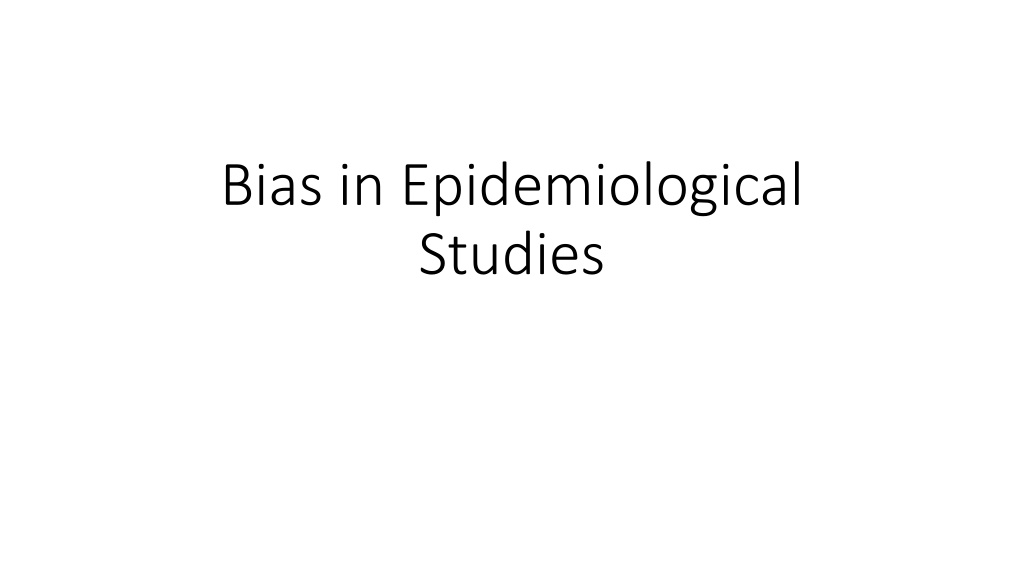
Understanding Bias in Epidemiological Studies
Explore the types of bias in epidemiological research such as selection bias, information bias, and confounding bias. Learn how these biases can impact study results and discover strategies to minimize bias for more accurate research outcomes.
Download Presentation

Please find below an Image/Link to download the presentation.
The content on the website is provided AS IS for your information and personal use only. It may not be sold, licensed, or shared on other websites without obtaining consent from the author. If you encounter any issues during the download, it is possible that the publisher has removed the file from their server.
You are allowed to download the files provided on this website for personal or commercial use, subject to the condition that they are used lawfully. All files are the property of their respective owners.
The content on the website is provided AS IS for your information and personal use only. It may not be sold, licensed, or shared on other websites without obtaining consent from the author.
E N D
Presentation Transcript
Bias in Epidemiological Studies
Outline Introduction Definition of Bias Importance of understanding bias in epidemiological research Overview of types of bias 2. Types of Bias Selection Bias Definition and examples How it occurs: improper selection of study participants Examples: non-response bias, loss to follow-up, healthy worker effect Information Bias Definition and examples How it occurs: errors in measurement or data collection Examples: recall bias, interviewer bias, misclassification bias
Outline. Confounding Bias Definition and examples How it occurs: mixing of effects between the exposure, outcome, and a third variable Examples: age, sex, socioeconomic status 3. Selection Bias Detailed discussion on selection bias Impact on study results Strategies to minimize selection bias Randomization Matching Restriction Using appropriate control groups
Outline 4. Information Bias Detailed discussion on information bias Impact on study results Strategies to minimize information bias Blinding (single, double) Standardized data collection methods Training of interviewers/data collectors
Outline 5. Confounding Bias Detailed discussion on confounding bias Impact on study results Strategies to minimize confounding bias Randomization Matching Stratification Multivariate analysis 6. Examples and Case Studies Real-world examples of studies affected by different types of bias Discussion on how these biases were identified and addressed
Outline. 7. Detection and Correction of Bias Techniques to detect bias Sensitivity analysis Subgroup analysis Methods to adjust for bias Statistical adjustments Propensity score matching Instrumental variable analysis
Outline. 8. Practical Applications Designing studies to minimize bias Evaluating existing studies for potential bias Reporting bias in research 9. Conclusion Summary of key points Importance of vigilance for bias in epidemiological research Questions and discussion
1. Introduction 1. Introduction Bias in epidemiological studies refers to systematic errors that can affect the validity of study results. Understanding and addressing bias is crucial for ensuring the accuracy and reliability of epidemiological research findings.
2. Types of Bias 2. Types of Bias Selection Bias: Occurs when there is a systematic difference between those who are selected for the study and those who are not. For example, if a study on occupational health only includes currently employed individuals, it may miss those who left work due to health reasons, leading to a "healthy worker effect."
2. Types of Bias. 2. Types of Bias . Information Bias: Occurs when there are errors in measuring or collecting data. For instance, recall bias can happen in case-control studies where cases may remember past exposures more accurately than controls. Confounding Bias: Arises when the effect of the primary exposure on the outcome is mixed with the effect of another variable. For example, if studying the effect of smoking on lung cancer without accounting for age, age could be a confounder.
2. Types of Bias. 2. Types of Bias . 3. Selection Bias To minimize selection bias, use randomization to ensure all participants have an equal chance of being selected. Matching and restriction can also help by ensuring comparable groups. 4. Information Bias Minimize information bias through blinding, standardized data collection methods, and proper training of data collectors. Ensuring consistent and objective measurement techniques is key.
2. Types of Bias. 2. Types of Bias . 5. Confounding Bias Randomization helps distribute confounders equally between groups. Matching and stratification can control for confounders by comparing similar groups, and multivariate analysis can adjust for multiple confounders statistically. 6. Examples and Case Studies Discuss specific studies, such as the Framingham Heart Study, and how they addressed biases. Highlight studies with known biases and their impact on results.
2. Types of Bias. 2. Types of Bias . 7. Detection and Correction of Bias Use sensitivity and subgroup analyses to detect bias. Adjust for bias using statistical methods like multivariate analysis, propensity score matching, or instrumental variable analysis. 8. Practical Applications Design studies with bias minimization in mind. Evaluate existing research for potential biases and report them transparently in publications.
9. Conclusion 9. Conclusion Bias is a critical concern in epidemiological research. By understanding its types, sources, and mitigation strategies, researchers can enhance the validity and reliability of their findings.
Questions for Discussion Questions for Discussion 1.What are some common sources of selection bias in cohort studies? 2.How can recall bias affect the results of a case-control study? 3.Discuss a real-world example where confounding was effectively controlled.










